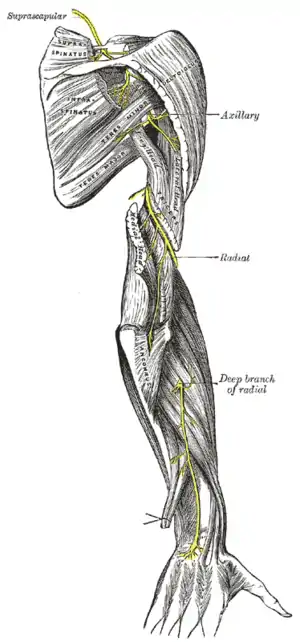Cheiralgia paresthetica
Cheiralgia paraesthetica (Wartenberg's syndrome) is a neuropathy of the hand generally caused by compression or trauma to the superficial branch of the radial nerve.[1][2] The area affected is typically on the back or side of the hand at the base of the thumb, near the anatomical snuffbox, but may extend up the back of the thumb and index finger and across the back of the hand.[1][3] Symptoms include numbness, tingling, burning or pain. Since the nerve branch is sensory there is no motor impairment.[3] It may be distinguished from de Quervain syndrome because it is not dependent on motion of the hand or fingers.[4]
| Cheiralgia paresthetica | |
|---|---|
| Other names | Wartenberg's syndrome |
 | |
| Radial nerve | |
| Specialty | Neurology |
Cause
The most common cause is thought to be constriction of the wrist, as with a bracelet or watchband (hence reference to "wristwatch neuropathy"). It is especially associated with the use of handcuffs and is therefore commonly referred to as handcuff neuropathy. Other injuries or surgery in the wrist area can also lead to symptoms, including surgery for other syndromes such as de Quervain's.[5] The exact etiology is unknown, as it is unclear whether direct pressure by the constricting item is alone responsible, or whether edema associated with the constriction also contributes.[3]
Diagnosis
Symptoms commonly resolve on their own within several months when the constriction is removed; NSAIDs are commonly prescribed.[4] In some cases surgical decompression is required.[4] The efficacy of cortisone and laser treatment is disputed.[4] Permanent damage is possible.
History
This neuropathy was first identified by Robert Wartenberg in a 1932 paper.[6] Recent studies have focused on handcuff injuries due to the legal liability implications, but these have been hampered by difficulties in followup, particularly as large percentages of the study participants have been inebriated when they were injured.[7] Diagnostically it is often subsumed into compression neuropathy of the radial nerve as a whole (e.g. ICD-9 354.3), but studies and papers continue to use the older term to distinguish it from more extensive neuropathies originating in the forearm.
See also
References
- Buttaravoli, Philip M.; Stair, Thomas O. "9.20 Cheiralgia Paresthetica (Handcuff Neuropathy)". Common Simple Emergencies. Washington: Longwood Information.
- Wartenberg, R. (1932). "Cheiralgia paraesthetica.(Isolierte neuritis des Ramus superficialis nervi radialis.)" (PDF). Zeitschrift für die gesamte Neurologie und Psychiatrie (in German). 141 (1): 145–155.
- Pećina, Marko; Krmpotić-Nemanić, Jelena; Markiewitz, Andrew D. (2001). "Chapter 26: Syndrome of the Superficial Branch of the Radial Nerve". Tunnel syndromes: peripheral nerve compression syndromes. CRC Press. pp. 152–155.
- Dang, Alan C.; Rodner, Craig M. (December 2009). "Unusual Compression Neuropathies of the Forearm, Part I: Radial Nerve" (PDF). Journal of Hand Surgery. 34A (10): 1912–1914. doi:10.1016/j.jhsa.2009.10.016. PMID 19969199.
- Chodoroff, G.; Honet, J. C. (Sep 1985). "Cheiralgia paresthetica and linear atrophy as a complication of local steroid injection". Archives of Physical Medicine and Rehabilitation. 66 (9): 637–639. PMID 4038032.
- Braidwood, A. S. (1975). "Superficial Radial Neuropathy". Journal of Bone and Joint Surgery. 57-B (3): 380–383. doi:10.1302/0301-620X.57B3.380. Archived from the original on 2011-07-24.
- Grant, Arthur C.; Cook, Albert A. (2000). "A Prospective Study of Handcuff Neuropathies" (PDF). Muscle and Nerve. 23 (6): 933–938. doi:10.1002/(SICI)1097-4598(200006)23:6<933::AID-MUS14>3.0.CO;2-G. Archived from the original (PDF) on 2011-07-08.